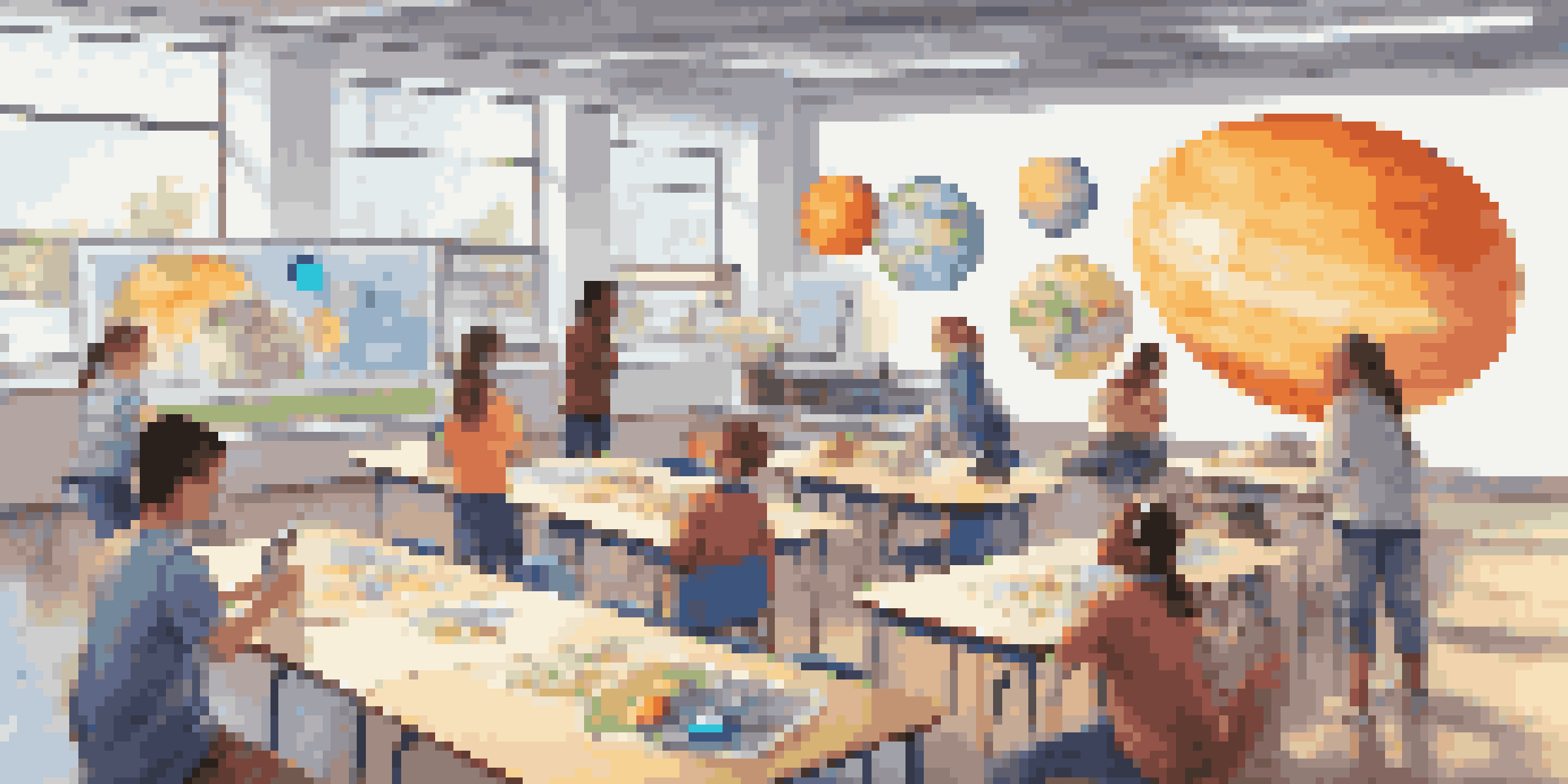AR and Student-Centered Learning Approaches

Understanding Student-Centered Learning Approaches
Student-centered learning is an educational approach that focuses on the needs and interests of students rather than on the teacher's agenda. This method encourages active participation, allowing learners to take ownership of their education. For instance, projects and collaborative activities often take center stage, fostering a sense of community and engagement among students.
Education is not the filling of a pail, but the lighting of a fire.
In this approach, teachers act more as facilitators than traditional instructors, guiding students as they explore topics at their own pace. This shift can empower students to ask questions and seek solutions independently, which enhances critical thinking skills. Ultimately, student-centered learning prepares learners for real-world challenges by promoting adaptability and problem-solving.
Incorporating technology into this framework can significantly enhance the experience. One such technology that shows great promise is Augmented Reality (AR), which can create immersive learning environments that captivate students' attention and curiosity.
The Role of Augmented Reality in Education
Augmented Reality (AR) blends digital content with the real world, allowing students to interact with 3D models and simulations in their immediate environment. This technology opens up new avenues for understanding complex concepts, making learning more engaging and interactive. For example, a biology class can utilize AR to examine the anatomy of a cell in a hands-on manner, rather than relying solely on textbooks.

By bringing abstract ideas to life, AR can cater to different learning styles, providing visual and kinesthetic learners with opportunities to explore topics interactively. This adaptability is crucial in a diverse classroom, where students have varying preferences and strengths. The excitement generated by AR can also motivate students who might otherwise struggle with conventional teaching methods.
Student-Centered Learning Defined
This educational approach prioritizes students' needs and interests, encouraging active participation and ownership of their learning.
Moreover, AR can foster collaboration among students, as they can engage in group activities that require teamwork and communication. This aspect aligns perfectly with student-centered learning, as it encourages social interaction and shared discovery.
Benefits of AR in Student-Centered Learning
Integrating AR into student-centered learning approaches offers numerous benefits, such as enhancing engagement and retention. When students can visualize and manipulate what they learn, they are more likely to remember the material. This active involvement can lead to deeper understanding and long-term retention of knowledge.
Technology is best when it brings people together.
Additionally, AR can help bridge the gap between theoretical concepts and practical applications. For example, in a physics class, students could use AR to simulate gravitational forces on various objects, allowing them to observe real-time effects. This kind of experiential learning can make the subject matter more relatable and relevant.
Furthermore, the use of AR can foster a sense of curiosity and exploration. Students may feel more inclined to delve deeper into topics, ask questions, and seek out additional information, which supports the core principles of student-centered learning.
AR Tools and Platforms for Educators
Fortunately, there are several AR tools and platforms available to educators looking to incorporate this technology into their classrooms. Apps like Merge Cube and Google Expeditions allow users to explore interactive 3D models and virtual field trips that can enhance various subject areas. These tools often come with user-friendly interfaces, making it easier for teachers to integrate AR into their lesson plans.
Moreover, platforms like CoSpaces Edu enable students to create their own AR experiences, promoting creativity and innovation. This hands-on approach not only engages students but also helps develop critical tech skills that are essential in today's digital world. Educators can tap into these resources to provide enriching experiences tailored to their students' needs.
AR Enhances Engagement
Augmented Reality brings abstract concepts to life, making learning more interactive and catering to diverse learning styles.
As AR technology continues to evolve, the possibilities for educational applications expand, making it an exciting time for educators to experiment and innovate in their teaching methods.
Challenges of Implementing AR in Classrooms
While the benefits of AR in education are significant, there are also challenges that educators must navigate. One of the primary hurdles is the need for adequate technology and infrastructure. Schools may face budget constraints that limit access to the necessary devices or internet connectivity, making implementation difficult.
Additionally, educators may require professional development to effectively integrate AR into their teaching strategies. Understanding how to leverage AR tools for maximum impact can be a steep learning curve for some teachers. Without proper training, the potential of AR might not be fully realized in the classroom.
Lastly, it's essential to consider how AR fits within the broader curriculum. Educators must thoughtfully align AR activities with learning objectives to ensure that they enhance rather than distract from the educational goals.
Future Trends in AR and Education
As technology continues to advance, the future of AR in education looks promising. Emerging trends indicate that AR will become more accessible and easier to use, enabling more educators to incorporate it into their classrooms. This democratization of technology could lead to widespread adoption and innovative learning experiences for students across various subjects.
Moreover, the integration of AR with other technologies, such as Virtual Reality (VR) and Artificial Intelligence (AI), could create even richer learning environments. For instance, combining VR simulations with AR overlays could provide students with unparalleled opportunities to explore complex scenarios, such as historical events or scientific phenomena, in immersive ways.
Challenges in AR Implementation
Despite its benefits, successful integration of AR in classrooms faces hurdles such as technology access and the need for teacher training.
In addition, as educational research continues to explore the effectiveness of AR, best practices and success stories will emerge, guiding educators in their implementation strategies. This ongoing evolution signifies a shift toward more interactive, engaging, and effective learning experiences.
Conclusion: Embracing AR for Student-Centered Learning
In conclusion, Augmented Reality presents a unique opportunity to enhance student-centered learning approaches. By encouraging active participation, collaboration, and exploration, AR can transform the educational landscape and make learning more engaging for students. As educators embrace this technology, they can create richer, more immersive experiences that cater to diverse learning styles.
It's clear that the integration of AR can lead to improved retention and understanding of complex concepts, ultimately preparing students for future challenges. With the right tools, training, and mindset, educators can harness the power of AR to ignite curiosity and foster a love for learning.

As we look to the future, it's essential for educators to stay informed about technological advancements and continually seek innovative ways to engage their students. By doing so, they can ensure that learning remains relevant, dynamic, and truly student-centered.